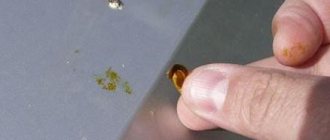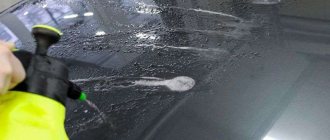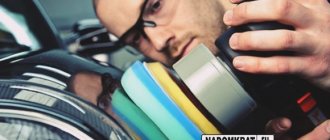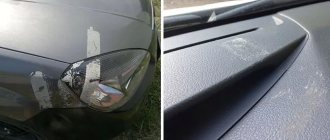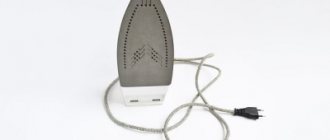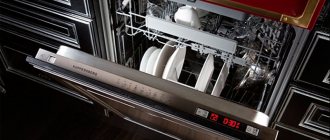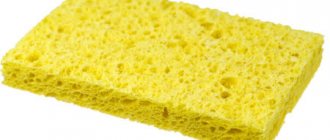Home » Stains of natural origin
Natural stains
Author Masha Klimova Reading time 6 min. Views 52.3k. Published 12/07/2016 Updated 05/04/2021
With the onset of spring, many car owners are faced with such a nuisance as the appearance of sticky poplar buds on the windshield, hood, and roof of the car. Removing sticky tree buds without damaging your car's paintwork is not an easy task.
Poplar buds contain a caustic resin that can penetrate the deepest layers of paint and, if not removed from the body in a timely manner, can turn into a hard dark speck. If this happens, it will be extremely difficult to cope with this type of pollution. Therefore, poplar or linden buds must be eliminated immediately, without waiting for them to penetrate into the paintwork.
Do not go straight to the car wash to remove these stains. As a rule, no one will bother with them at a car wash, especially since they do not always have both a cleaning agent and a gentle agent that does not leave scratches on the surface of the paintwork. Very often, after a car wash, small scratches remain on the car, which can only be removed by deep polishing. But even when cleaning the body yourself, not all products can be used so as not to cause damage to the paintwork.
It is best to protect your car from the appearance of this type of stain, namely:
- If possible, do not park under trees such as poplar or linden
- buy a protective cover for your car
- or with the onset of spring, cover the surface of the body with a specialized polish that has a prolonged effect. This layer of polish will create a thin layer of film that will have a protective effect for several months.
But if such a nuisance does happen, then it is necessary to think about all possible ways to remove traces of poplar buds from the car body, without causing damage to the timber plant.
Techniques for removing stains from a car
Before you begin the cleaning process, you need to put the car in a garage or other place where there will be no direct sunlight and remove the fat layer from the surface that will be treated. It is recommended to wash the entire car with regular soapy water or car shampoo before cleaning. After the greasy layer has been removed from the surface of the paintwork, you can begin to choose a method and means for cleaning poplar buds. It is also necessary to stock up on soft absorbent fabrics.
Never use hard, melamine sponges or dense materials for cleaning.
What should you not do?
To avoid damaging the car body, you should not make the following mistakes:
Do not use solvent 646, pure acetone or solvent to remove stains. These compounds are too aggressive, so together with the resin they will dissolve the paint that covers the car.- You cannot start cleaning if the machine is dirty. First you need to wash it. This will make the stains more visible.
- Do not use abrasive compounds such as baking soda or stovetop cleaning powder to remove resin.
- Do not use hard kitchen sponges, brushes or sandpaper for cleaning.
Solvents for household use
- Such solvents: acetone, 646, solvent can dissolve any complex stain, even old stains from poplar buds, but along with them, the paintwork can also deteriorate if these products are left on the treated area for at least a couple of seconds more than the required time.
- Another commonly used household solvent is white spirit. This is a milder substance. With the right approach to the cleaning process, white spirit can completely remove linden stains. But poplar stains are not completely washed away: yellow spots remain on the surface of the light-colored body. If the cleaning technique is incorrect (using a hard sponge, vigorously scrubbing the kidneys from the body), the top layer of coating can be erased.
- You can use a product to remove poplar buds from imported manufacturers, but if you carry out the cleaning immediately after the buds appear on the body. These products are not able to dissolve and remove older stains.
Excellent in the fight against kidney problems
The bitumen stain cleaner from the Astrochem company performed well. It is necessary to remove the bud itself, apply the product to the stain that remains from the poplar bud, wait 2-3 minutes and remove with a soft sponge or microfiber.
How to clean bitumen from the road?
Bitumen on a car is a common thing for car owners. It is enough to drive along a section of road that is being repaired or is hot, and dark stains from tar will cover the body. They can be removed either with improvised means or with specialized compounds.
Liquids at hand
Folk remedies for getting rid of road tar:
- Petrol. Every motorist always has it with him.
You can use it at any convenient time. Gasoline does an excellent job of removing both fresh and old stains, but in the latter case you will have to put in more effort. It is easy to use; just apply gasoline to a rag and wipe the dirty surface. You need to act carefully, without making much effort, since the paintwork may come off along with the bitumen. Diesel fuel and kerosene have a similar effect. - Nail polish remover . It is based on acetone, so it easily copes with tar stains. The only condition is the refusal of intense friction.
- Sunflower oil . It can be used to get rid of fresh stains before they have time to harden. Apply the oil to a rag and rub it until the body is completely clean. It will take a little effort and time, but the result will satisfy the car owner, since the oil not only removes road tar, but also does not harm the paintwork.
The video will show you how to clean your car from bitumen stains:
Cleaners
If you don’t want to use improvised means, or they turn out to be ineffective, you can purchase special substances in the store that were developed for this purpose. Popular road tar cleaners:
GraSS Antibitum
The product is effective against all types of resins, bitumen and stains from poplar buds. It acts quickly, within 1-10 minutes .
GraSS body cleaner for removing bitumen stains Antibitum is applied to the contaminated surface, left to soften the resin, rubbed and washed off with water with the addition of a degreaser.
The price of a 0.5 liter bottle is 210 rubles.
Autoland
The composition is designed specifically for the care of painted car parts . It is effective against resins, insect marks, poplar buds and bitumen stains.
Autoland body cleaner for bitumen stains and insect traces is applied to the stain for 1-3 minutes, after which it is removed with a foam sponge. If necessary, repeat the procedure.
The price for a 0.5 liter package is 180 rubles.
RunWay
Before use, shake the bottle and then distribute the composition evenly over the surface . After 30 seconds, you need to quickly remove dirt, without pressing. The main active ingredient in RunWay body cleaner for bitumen stains is aviation kerosene.
The price of a 0.5 liter bottle is 250 rubles.
Traditional methods
- You can remove poplar buds from a door lock using gasoline , which can cope with this type of contamination without any problems. But it is not advisable to use gasoline to remove stains from the body, as it may leave traces.
- Another effective remedy for removing poplar buds is pure alcohol. They just need to moisten the cloth and apply it to the problem area for a few minutes. The stain should dissolve, and the treated area should be washed with soapy water.
- , glass cleaners, sunflower oils, various colognes, nail polish removers that do not contain acetone, and even Coca-Cola are used as folk remedies to combat poplar traces , but all these means are not able to clean poplar resin one hundred percent, especially on the surface of the vehicle is light in color.
- Ammonia can also remove tree sap from the hood or roof of a car, but you should be extremely careful when using it, as there is a high risk of damaging the varnish layer. Before using it, you need to use a hairdryer to warm the stain well and wipe it off with a soft cloth soaked in ammonia. After cleaning, wash the machine with soapy water.
Helpful information
Tips to help you cope with the task more effectively:
- Before using detergent on a visible area of the car, you need to test it in an inconspicuous place. If the paintwork does not change color or wash out, you can begin to remove the resin.
- If you don't have a cleaner or solvent on hand, you can wipe off tar stains with WD-40. Almost every motorist has a can of this product. The composition is especially effective in combating fresh stains.
- Most resin removers are based on petroleum fractions, so they are flammable and also have a specific odor. Therefore, you need to work with them carefully.
- If the stain is large, then remove it point by point. Apply the product using a brush. This is a rather tedious task, but this way you will be able to avoid subsequent painting of the car.
- After treatment, the car must be washed using car shampoo.
Recipes and tips for removing resin from various surfaces are presented in this section.
Machine cleaning process
- After washing the car and choosing the most suitable cleaning product, you can begin the process itself.
- Initially, it is necessary to remove all poplar buds from the surface of the body by hand.
- Then apply the selected product to problem areas of contamination and carefully, using a soft cloth, remove the stain with light movements.
- After cleaning, the car must be washed with car shampoo.
In cases where stains cannot be removed using any of the various methods, abrasive polishing can be a solution to the problem - the service is not cheap, but the result is a shiny car body, without any stains or scratches.
Dear visitor! If you know other methods on how to remove stains, please leave your experience in the comments.
To clean your car from tar or tree buds, use hand sanitizer.
Together with unscrupulous or incompetent auto mechanics, fines from traffic police cameras and various vehicle malfunctions, buds falling from trees and adhering resin are just as unpleasant and the worst nightmares for any car enthusiast. The fact is that adhering resin and tree buds getting on the car seriously damage the paintwork of the car body. Due to the specific chemical composition of tree resin or buds, it will be very, very difficult to wash them off the car body using traditional methods. Many car owners resort to various chemical compounds (products) sold in car dealerships, spending a lot of money on them. Some car owners go straight to the car wash, hoping there to clean their car of tar and bud stains that have formed. But don’t rush to get to the car wash, friends, there is a simpler and quicker easy way to easily remove resin from the body of your car. And what is interesting here and most importantly, this method is the cheapest, simplest and most reliable, it carries less risk of damaging the factory paint of the car body.
See also: Ten myths about car washing and car washing
For our part, we have nothing against various special chemical detergents. But not all products on the market can cope with formed and difficult to remove stains on a car. On the contrary, some products can damage your car while cleaning it from stains.
So friends, take your time and be careful when choosing products for cleaning your car from tar or other very sticky contaminants.
But for our part, we think why waste your precious time studying a large and even huge amount of chemistry (chemicals) for cleaning a car..(?) After all, in any chain grocery supermarket (usually at the checkout) or in any pharmacy you can freely purchase hand sanitizer, which is used daily by millions of citizens around the world. Using this hand sanitizer, you can easily clean your car from adhering resin and stains caused by tree buds (especially spruce and poplar buds) without resorting to other more costly and time-consuming methods.
Firstly, if you notice that the body of your car is covered in sticky resin stains, then please do not try to clean it (the body) with a damp cloth, this will not help remove the sticky substance. In any case, you need something more powerful and reliable to remove tar from your car.
Here's what you first need to do to quickly and easily remove resin, tree buds or other sticky substances that have gotten on the body from your car's paintwork.
It is necessary to prepare a hand sanitizer (preferably not a cheap one and from a well-known brand) to remove tar or other adhering substances.
Why are poplar buds dangerous for cars?
Depending on the region, poplar buds begin to ripen and fall on the body, windows, and wheels of the car in late spring or early summer. They contain resin, so the buds stick securely, and if they fall off, they leave a noticeable mark behind.
Once resin gets on the body or glass, dust and dirt begin to stick to it. After some time, the resin penetrates deeply into the paintwork and turns into a dark and hard stain. There are effective ways to remove recently poplar buds from a car, but if you waste time, it will be very difficult to deal with this problem.
Depending on the region, poplar buds begin to ripen and fall on the car in late spring or early summer
Don't trust car washes. Typically, the professionals working there do not have time to treat and remove every stain. They often scrub them off forcefully using a rag or sponge. Thus, damage is caused to the paintwork in the form of a fine network of scratches. To eliminate it, you will have to deeply polish the body.
How to remove resin from metal
This problem is familiar to motorists who have had to drive on newly paved roads. After this, stains and streaks of resin (bitumen) remain on the surface of the body. If they dry out, it is very difficult to remove them, so such contaminants must be removed as quickly as possible.
When removing any tar stains, it is important to follow safety rules: protect your hands with gloves or special cream, work in a well-ventilated area without possible sources of ignition.
Note: test review of automotive resin cleaners
Just as in the case of gasoline additives for cleaning injector nozzles, quite a few auto chemical manufacturers have rolled out their anti-bitumen products to the market. There are representatives of both well-known foreign companies and domestic teams.
The magazine "Behind the Wheel" tested products from various manufacturers. The essence of the test procedure was to evaluate the effect after using the drug in full accordance with the instructions. Resin cleaners from the following companies took part in the “race”:
- Liqui Moly (Germany – 475 rubles/400 ml).
- Kangaroo (Korea – 330 rubles/400 ml).
- Grass (Russia – 255 rubles/500 ml).
- Doctor Wax (USA – 690 rubles/475 ml).
- Autoprofi (Russia – 170 rubles/500 ml).
- Astrohim (Russian Federation – 150 rubles/500 ml).
- Sonax (Germany – 460 rubles/300 ml).
- Pingo (Germany – 520 rubles/400 ml).
- Texon (Russia – 140 rubles/520 ml).
Conventionally, products are divided into two groups: fast-acting (Astrochem, Liqui Moly, Kangaru, Avtoprofi, Sonax, Pingo), requiring long exposure (Grass, Tekson). Theoretically, the following is expected: the former do not drain, concentrating the entire volume on the affected area, the latter dissolve stains more effectively, but require more consumption. Practice confirms this.
When choosing, it is important to consider the smell. The procedure for interacting with the drug is often slow, so the aroma should not be strong
Everything is aimed at not causing discomfort to the operator, especially in the heat. The mixture from Astrohim most accurately satisfies these conditions.
Almost all compositions cope with the task with dignity. However, there are still favorites - Texon and Astrohim. At a minimal price, they fulfill their purpose as transparently as possible. Let Tekson complete the task with a significant amount of time (withstand at least 5-10 minutes), but he washes off poplar resin and road petrochemicals the first time.
How can you wash linden, poplar and pine from the surface of your car at home?
There are many examples of the use of household or pharmacy chemicals. Why is this direction attracting more and more car owners? The fact is that the properties of some drugs are not inferior to analogues from thematic auto chemical products, and their price is several times less. To be fair, we can give an example from a related area: how to polish plastic headlights yourself by hand - with toothpaste for several tens of rubles or a polishing kit for several thousand rubles?
So, you can wipe off poplar resin without a trace, traces from linden or glue from pine onto fresh:
- Ammonia (a solution of ammonia in water).
- Alcohol solution of boric acid (3%).
- Blue clay.
Coming closer to the technology of using this chemistry, the following point arouses interest: are they able to wash off the resin without harming the paintwork. Will this treatment leave various scratches and dull abrasions on the surface of the body?
Clay or medicines
When comparing contenders based on the level of damage caused to paint, clay is a clear outsider. It removes Velcro due to friction. When using alcohol and acid, there is practically no trace of it (it takes a little effort to wipe the stain, and the main mechanism for removing the tar residue is to dissolve it within 10-20 minutes).
Blue clay is often associated with a hologram effect. They say that if you rub in a circular motion, the treated surface will be noticeably different from the untreated one. In theory, it is necessary to scrape off poplar glue and resin residues from other trees only with translational longitudinal movements, without strong pressure, after first moistening the defective area with a soap solution.
In theory, following these rules, the treatment should pass without a trace for the paintwork. But in reality, many observe the opposite - there is a hologram. It is very visible in the sun, on black metallic, and completely undetectable on a white car. Therefore, dark cars require final polishing of the body.
Ammonia and boric acid do not spoil paintwork at all. Negative reviews about them are associated with ignorance of the technology, how to remove poplar buds or Velcro from linden or pine from the surface of a car with your own hands. There is only one remark about the drugs - they act slowly.
What about petroleum based solvents?
Products of petroleum origin and tree resin are reluctant to be washed off. We are talking about such varieties as:
- White Spirit.
- WD-40.
- Kerosene.
- Petrol.
- Carburetor cleaner.
Universal white spirit will only save you from minor contamination. If they can still remove a fresh tarry trace, then even a two-day-old trace of a solvent-like liquid cannot be removed. WD-40, gasoline, kerosene and carburetor cleaner do a better job than white spirit, but they are far from being as effective as medications.
Other means
The global automotive and household goods industry does not stand still. For example, wet wipes with alcohol appeared relatively recently. In the fight against fresh marks, they have proven themselves to be a good remedy. You just need to brush off the buds so that they don’t open. How to do this is one of the topics of further discussion.
Automotive stores also have interesting, modern items for removing stubborn stains. For example, a towel or anti-scrub mitten. The rubberized product copes well with tar stains, but again cleans due to friction. Therefore, the issue with mechanical polishing is not closed.
Use of alkali and ammonia
Resin is removed from the boards using alkali solutions, and the surface must be unpainted. Otherwise, the remnants of cleaning compounds dry out and crystallize, destroying the paintwork. To prepare an alkaline mixture, dissolve 50 g of soda or potash in 1 liter of water, adding 250 ml of acetone to the container.
When using caustic soda, 0.25 g of powder is placed in a solvent, which is cold water in a volume of 0.5 ml and 250 ml of acetone. During processing, the alkali must be hot, and afterward its residues are neutralized by pouring plenty of water and a solution of acetic acid in a ratio of 1:50.
Another cleaning option is to remove the resin with a mixture of ammonia and acetone, applied with a brush. After 20 minutes, the resulting foam is washed off and the boards are rinsed with plenty of clean water. To achieve maximum effect, the procedure is repeated 2-3 times.
Removal of resin from the surface of coniferous boards is carried out after thoroughly sanding the surface. The need for such treatment is due to the penetration of cleaning compounds into the wood no deeper than 1-2 mm. With further heating, the resin may appear even if the surface of the boards is coated with paint and varnish.
How to remove poplar resin, traces of linden and pine from a car body with your own hands
Getting rid of Velcro means making sure that not even a speck remains from the contact of a tree bud with the paintwork.
As already noted, the fourth day is the deadline when the body surface can still be saved without the use of polishing. Later, chemistry is no longer able to remove the famous yellowness that remains after removing the resin. The proposed method is relevant precisely from the moment the poplar, pine or linden tree gets in contact with Velcro until the end of the fourth day:
- Remove buds from the body surface. This must be done so that the resin does not leak out of them. Use the following method: dampen a cloth in warm water, wring it out as much as possible and brush the tree flowering products to the side. Dry rags are not suitable for these purposes - they do not allow brushing. You should not remove it with your hands or a brush - the Velcro will open at the slightest hard touch.
- Wash the outside of the car. Contactless washing is preferred because it leaves fewer scratches.
- Wipe the body dry. There is no need to worry about defective areas - ingrained resin cannot be smeared with a rag.
- Remove tar stains. Soak a piece of cotton wool or a cotton pad in alcohol/acid and, without applying much effort, wipe off the resin. In most cases, the Velcro mark needs to be soaked: place a swab soaked in chemicals on the contaminated area and leave for 10-15 minutes. After soaking, the stain is removed with a slight movement of the hand.
- Final cleaning of the treated area. Produced using special auto chemicals to remove resin. Usually this is any can with the Bug & Tar Remover attachment. The operation is not always necessary; it is done at will.
How to protect your car from kidney damage in the future
In order not to encounter such a problem, it is necessary to take preventive measures. To do this, just adhere to the following rules:
- You cannot park your car near a poplar tree. If it is very necessary, then only for a short time;
- use underground parking lots and parking lots;
- Regularly apply special products to your car, which contain wax, silicone, and Teflon. They create a protective film and the resin is easier to remove;
- if you leave the car in an open area for a long time, it is better to cover it with a special cover;
If you leave the car in an open area for a long time, it is better to cover it with a cover. - You can cover the car body with a protective film. Thus, the paintwork is protected from dirt and fading.
The sooner traces of poplar buds are removed, the easier it will be to do this. There are different ways to do this and you can choose the one that suits you. Old tar stains can sometimes only be removed by mechanical polishing of the surface.
Prohibited actions
If it was not possible to avoid contamination from poplar buds, the main thing is to properly clean the car so as not to cause even more harm. You cannot remove such defects with stain removers in the sun; it is better to carry out the procedure in a closed space. When removing stains, you do not need to be zealous; you need to clean linden and poplar Velcro with light movements, without using brushes, abrasive pastes, or sponges. Before cleaning, the car should be washed with shampoo, degreasing its surface. All these precautions will help remove poplar stains without causing damage to the car.
Resin is a natural property of coniferous wood
Coniferous species are mainly used as construction wood for wooden house construction: pine and spruce. When painting conifers, one should take into account the presence of resin in the wood, which, due to the capillary effect, tends to reach the surface. This process is natural, but often undesirable: on painted wooden facades you may notice contrasting yellow spots or smudges of resin drops. What to do in this case? Can any façade paint seal the resin? Such questions are often asked by our customers. This problem is actively discussed on Internet forums, but there are often contradictory and unprofessional statements there. We addressed this question to Finnish specialists from the Teknos , who are developing materials for painting wood. The answer was unequivocal: if coniferous wood with a high resin content was used for construction, then there is no paint and varnish material that would be guaranteed to eliminate the appearance of resin. As confirmation, we provide a photo provided by one of the construction companies. The facade of the wooden house in the spring of 2022 was painted with the popular material Vinha (Tikkurila) . In the autumn of the same year, clearly visible yellow spots around the knots already appeared on the facade, and in some places you can see the release of resin in the form of drips. “Protrusions” of resin from under the covering paint are visible on the façade.
Insects. Evil is in their blood
Insects are such a nasty thing. If in the city they are annoying, then outside the city they simply harass motorists. A cloud of midges instantly deprives the driver of his vision, and at high speed such a “surprise” is a direct road to an accident. Water and wipers cannot cope with the mess of broken insects. It can be done quickly only with the use of special detergents. And if insects break on a hot hood, then a new risk arises: the mush quickly combines with the softened varnish, and along with it, hard inclusions - chitin and dirt - penetrate into the paint.
Coca-Cola has proven itself to be a great cleaner. It is also suitable for removing insects from the hood and windshield. The part that needs to be washed is first washed with water to wash away debris. At the second stage, the surface is moistened with a drink. Give it a little time to work and rinse off with plenty of water.
Insects need to be removed using special means and as often as possible so that the caustic porridge does not have time to penetrate the varnish. If a car with insects sits in the hot sun for several days, you cannot clean it yourself, because there is a risk of damage to the paintwork. The right decision is to take the car to a detailer. There it will be washed using a special shampoo, and damage, if any, will be polished.
Myth. Regular dish detergent and a dish sponge will wash insects off the hood in one go!
Is it true. If at the moment of contact with the insect the surface was cold, and the traces are washed off immediately - fresh, then yes: no consequences will happen and “Fairy” will cope. But if the insects accumulated on the already hot hood, and even “fried” in the sun in a traffic jam, then you need to go to the car wash without delay. Before washing, all flip flops should be treated with special insect removers. And be sure to read the instructions!
How to protect your car from insects?
The most troublesome way: clean the LPK every day using special cleaners. However, even with this approach, the safety of the varnish is not guaranteed. A more reliable option: cover the body with a protective compound or films.
